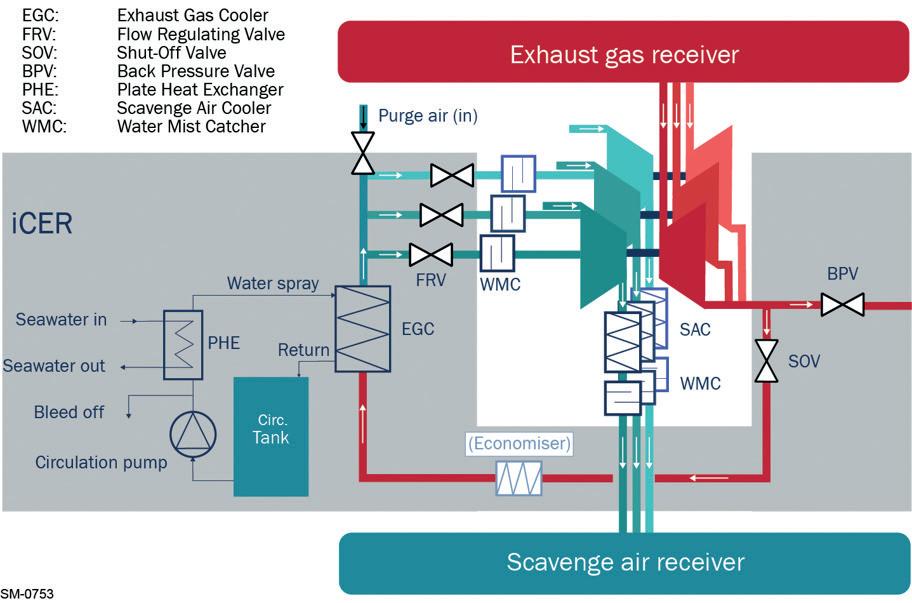
16 minute read
Methane slip advance
WINGD LOWERS METHANE SLIP BELOW 1G/KWH IN TEST
During The Motorship’s recent Propulsion and Future Fuels conference in Copenhagen, Dominik Schneiter, VP of Research and Development at engine designer WinGD, announced that the company had made a significant advance in reducing methane slip.
Schneiter revealed that WinGD had recently completed a test of concept trial of the extension of the Intelligent Control by Exhaust Recycling (iCER) solution to multiturbocharger applications upon a production engine in China. During the trial it had successfully lowered methane slip emissions below 1g/kWh.
The achievement was a technical milestone in the reduction of greenhouse gas emissions from Otto cycle engines. Schneiter noted that this reduction below 1g/kWh represented “a record low for any lean-burning engine”.
As reported by The Motorship, WinGD’s iCER solution offers superior fuel efficiency and lower methane emissions by recirculating a significant proportion of exhaust gases.
In autumn 2021, WinGD has successfully validated the system, during a test of a 9X92DF engine rated at 42,560kW on a test system in China. The test system itself was designed to fit a larger 10X92DF engine rated at 51,680kW.
The trial results demonstrated that the solution was compliant with IMO Tier II in diesel mode, offering a fuel consumption improvement of >8g/kWh, but the more significant results were achieved in gas mode, where the solution was able to run higher compression ratios, resulting in a greenhouse gas emissions (GHG) reduction of “over 8%” using this technology. The NOx emissions were lowered below 0.5g/kWh during the gas mode, Schneiter added.
The concept was likely to be of particular interest to potential customers in the container vessel market, Dominik Schneiter noted, adding that the solution had been successfully demonstrated to selected customers and classification societies.
First AIP for firing boilers with methanol
8 WinGD has
successfully lowered its methane slip emissions below 1g/kWh in a recent trial of its Intelligent Control by Exhaust Recycling (iCER) solution (pictured) for multiple turbochargers
Classification society ABS has granted Alfa Laval the first marine approval for operating boilers on methanol. Alfa Laval received an approval in principle (AIP) on 4 November 2021, based on extensive solution testing at the Alfa Laval Test & Training Centre.
Methanol, which is liquid at ambient temperatures and carbon-neutral if produced from green sources, is the next likely fuel step in decarbonising the marine industry. While methanol can be found on a handful of vessels and is planned for many more, its use has so far been limited to main engines. In the future, methanol operations will need to extend to boilers.
“Alfa Laval is looking at the full scope of methanol’s influence on board,” says Lars Skytte Jørgensen, Vice President Technology Development, Energy Systems, Alfa Laval Marine Division. “The most natural choice for boilers is to fire them with the vessel’s primary fuel, but methanol’s low-flashpoint nature and the differences in its energy density require a new approach to the burner and fuel supply systems. It was important for us to develop that approach, and we are proud to have it validated by ABS.”
Alfa Laval has been testing boiler operations with methanol since early 2021 at the Alfa Laval Test & Training Centre, where engine combustion tests with methanol are also underway. Tests have been conducted using a pressure-atomising MultiFlame burner on an Alfa Laval Aalborg OS-TCi boiler, as well as a methanol valve unit (MVU) designed by Alfa Laval to meet the class requirements from ABS.
Initial results, obtained with both pure methanol and a methanol-water mixture, showed as expected that methanol is easy to ignite and results in very low emissions. Focus was therefore placed on securing the same steam output with methanol – despite its lower heat value – as would be the case using oil or gas as fuel. A solution was reached after a few adaptations, ensuing that a boiler of a given size can produce the same amount of steam regardless which fuel is used. This meant that development could move rapidly to optimising the fuel supply system and working with ABS on the methanol AIP.
With the AIP in hand, the next step for Alfa Laval will be a pilot installation on an ocean-going vessel. Results from field testing will be crucial in fine-tuning the methanol boiler solution and arriving at a commercial design.
Meanwhile, Alfa Laval is pursuing wider optimisation possibilities that will compensate for methanol’s lower energy density and higher price. One of these is the use of an Alfa Laval Aalborg Micro economiser in conjunction with the OS-TCi. By absorbing waste heat from the boiler’s exhaust gas, the Aalborg Micro would recover valuable energy and reduce boiler-related fuel consumption by roughly 10%.
DUTCH PORT PROJECTS LOOK TOWARDS ANNEX III SOLUTIONS
While European port operators focus on the mechanics of upcoming EU regulations for shore power connections. Dutch projects are focused on developing alternative fuel supply solutions.
In an official statement in November Isabelle Ryckbost, ESPO’s Secretary-General said: “Let’s now work together with all policymakers and stakeholders to move forward towards investing in technologies that are effectively being used and that lead to effectively reducing the emissions of shipping, both at berth and during navigation.”
Europe’s ports have welcomed the review of the current AFIR proposal accompanied by provisions in the new FuelEU Maritime Proposal requiring vessels to use shore-side electricity infrastructure at berth.
There is a need for full alignment between what ports need to do and the obligations for shipping lines, including a full alignment of Article 9 of the AFIR proposal with Articles 4 and 5, as well as with Annex III of the FuelEU Maritime proposal.
The Motorship notes that the AFIR proposal currently only addresses the shore side electricity installation in the port, thereby overlooking the issues of grid connectivity, grid capacity and grid conversion.
ESPO has called for wider electricity grid strengthening issues to be tackled in the proposals as they are essential to make installed SSE operational. The installation of substations, as well as grid connections and strengthening the grid can be required to ensure the supply of shore-side electrical power to certain vessels. Such installations and upgrades are often outside the remit of the port authority/ port managing body.
Prioritisation is essential in that respect. For ESPO, it would be more effective to define the scope based on a minimum level of traffic volume per terminal (instead of per port) to prioritise busy terminals and avoid underused capacity being installed.
A separate issue relates to operational requirements, as ports will need to know if a shipping operator intends to use onshore power supply or rather one of the other alternative technologies foreseen in the Annex III of the proposal.
While ESPO looks forward to working with the EU Parliament and the Council to deliver a ‘coherent package’, the ports of Amsterdam and Rotterdam and stakeholders are still researching the viability of expanding shore power facilities for seagoing vessels.
Dutch shorepower projects
As yet there are no final results about the Amsterdam-based sectors that test a battery that can be fuelled with local wind energy or with biomass for shore power. Electricity supplier Eneco and the Port of Rotterdam still conduct a feasibility study for the use of cold ironing at the Vopak Europoort Terminal.
Due to the side effects of Covid, the studies are slightly delayed, although the building of a kind of hydrogenpowered port vessel – as part of the project – has been commissioned. The battery-electric 20-metre long vessel will be deployed in the port of Amsterdam in 2023.
The Port of Rotterdam, Eneco and Heerema materialized a joined study for cold ironing at Caland Canal. Recently their collaboration resulted in the installation of two 10 MW Shore Power connections to fuel the Heerema fleet.
The seaport and the City of Rotterdam are also busy completing a joint shore-based power strategy. The objective is to have eight to ten shore-based power projects in place before 2025. It is to be a learning process to roll out shore power on a large scale throughout the port area after 2025.

Annex III technologies
In parallel with investment into shorepower connections, research into potential Annex III technologies is continuing in the Netherlands. The Dutch government recently allocated EUR150 million (US$169.7 million) towards eight industryresearch institute partnerships to stimulate the development of decarbonisation technologies in the maritime, aviation and automotive even sectors.
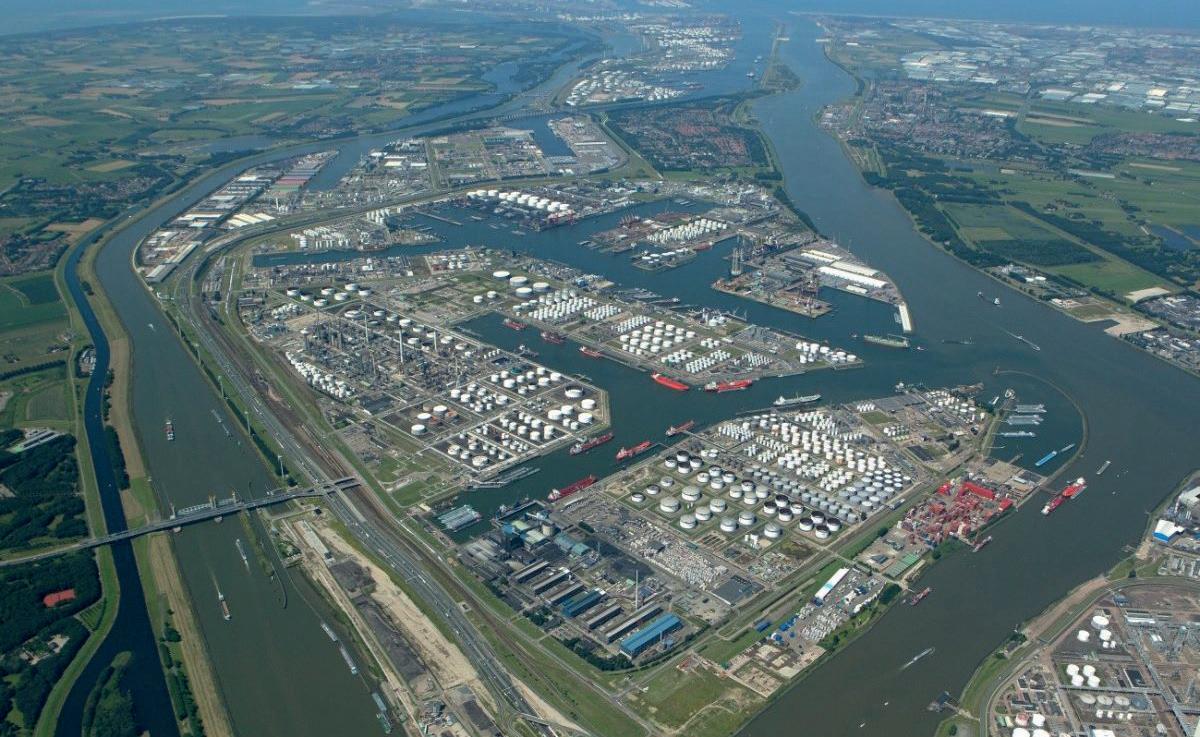
8 The Port of
Rotterdam is currently active in the development of a CCUS project, the Port of Rotterdam CO2 Transport Hub and Offshore Storage project (Porthos).
8 Isabelle Ryckbost,
ESPO’s SecretaryGeneral
Credit: ESPO
The partnerships include three projects focused on hydrogen carriers, methanol, and green LNG, respectively. LNG_ZERO to reduce the LNG propelled vessels substantially, MENENS that focus on methanol as a sustainable fuel for shipping, and Sustainable H2 Integrated Propulsion Drives for vessels.
LNG-ZERO
The LNG-ZERO project is intended to accelerate the development of an innovative circular approach using recycling CO2 captured on board LNG-fuelled vessels to produce synthetic LNG using electricity from renewable energy sources (such as offshore wind).
The project brings together Netherlands-based shipowners, such as Antony Veder and Heerema, with suppliers, such as VDL AEC Maritime with Carbotreat and Carbon Collectors, and TU Delft and TU Twente. The project is also being supported by Shell, as well as Port XL, a Rotterdam-based technology accelerator. The project has an EUR6.1 million budget, to which the Dutch government has contributed EUR4.4 million.
The project is also intended to develop technologies to significantly reduce methane slip (CH4) and NOx emissions from LNG-fuelled vessels and will also examine potential integration with carbon capture use and storage (CCUS).
The Port of Rotterdam is currently active in the development of a CCUS project, the Port of Rotterdam CO2 Transport Hub and Offshore Storage project (Porthos). The project brings together Energy Beheer Nederland, Gasunie and the Port of Rotterdam, and is intended to store an annual amount of 2.5 million tonnes of CO2 from industry in empty gas fields beneath the North Sea from 2024.
ETS funds
European Community Shipowners’ Associations (ESCA) President Claes Berglund takes R&D in environmental protection seriously from a broader perspective. In an official statement, he advocates for a dedicated fund to be set up under the EU ETS to stabilise the carbon price, which is especially important for the many shipping SMEs. “Importantly, generated revenues should support the uptake of clean fuels,” he said, adding that ECSA’s first preference always is an international regulation for shipping at the IMO level.
Dutch Royal shipowners’ association KVNR environmental specialist Nick Lurkin underlines ESCA’s statement for the Dutch affiliate, adding that the overall focus is not particularly on shore power. However, developments in cold ironing are mentioned. “We should stress the need for uniformity in connection and power of shore power supply onto smaller vessels and container carriers, preferably worldwide but certainly in Europe”, he said.
He added that the safety and capacity of renewables are also topics in climate protection discussions. “IMO is sometimes accused of acting slowly, but the organisation is in the forefront in the development of safety in the use of hydrogen. As yet, it is still subject to find out the real benefits
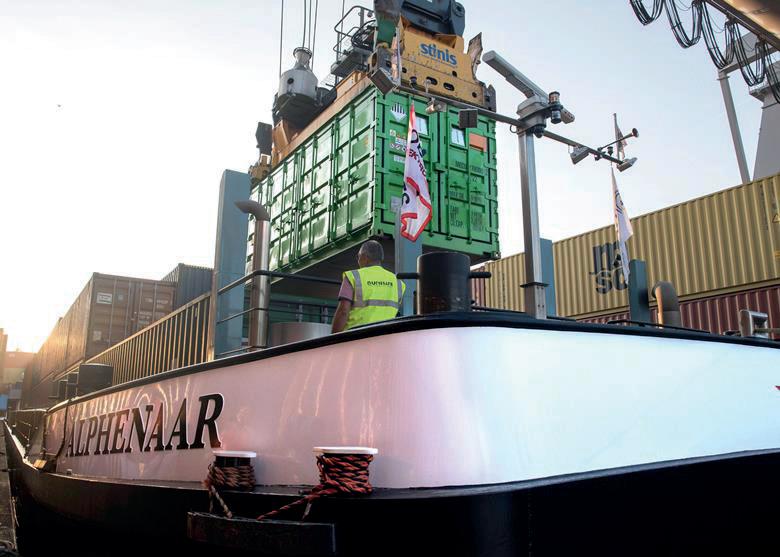
of use and the need to adjust vessels technically to this particular kind of fuel.”
Assistant Professor Marine Engineering Klaas Visser at the Delft University of Technology welcomes all developments in research and use of hydrogen and other renewables, shore power included, for seagoing vessels and inland navigation. When talking to The Motorship he mentioned the first Dutch electric propelled barge Alphenaar (length 90 metres, with 10.5, 1,900 tonnes carrying capacity). CCT deploys the pure-electric barge between Alphen aan den Rijn to Moerdijk for a daily service for brewery Heineken. The two ZESpack containers of 2000kWh guarantee two to four hours of propulsion to cover 50 to 100 kilometres.
Wider energy transition aspects
The Netherlands government announced a hydrogen strategy in April 2020. The strategy designated the north of the country as a Hydrogen Valley, with up to EUR850 million expected to be invested in industrial projects between 2021 and 2025. The strategy included a focus on the promotion and development of a fuel cell manufacturing cluster in the region.
The government is also supporting efforts to modify the country’s existing natural gas transmission network to store and transport hydrogen as fuel. The country’s gas network operator, Gasunie, is developing a hydrogen network to connect the northern seaport Delfszijl/Eemshaven with Amsterdam, Rotterdam/Moerdijk and southern Zeeland and southern Limburg by 2025.
8 The pure electric
barge Alphenaar

8 Assistant
Professor Marine Engineering Klaas Visser at TU Delft
FUNDING TO ACCELERATE DUTCH HYDROGEN FUEL CELL PROJECT
A Netherlands based consortium intended to accelerate the introduction of hydrogen into the maritime sector has been awarded a grant of EUR24.2 million (US$27.4m) from the country’s R&D Mobility Fund.
The project – SH2IPDRIVE – is intended to develop the application of hydrogen in the maritime sector. The project has a total budget of EUR34 million, with the consortium’s participants contributing EUR9.4m, which will be used to support research and development into multiple avenues for hydrogen.
While the consortium has a strong focus on inland waterway applications, which is the focus of two of the project’s five concept designs (covering newbuilds and retrofit solutions for inland shipping), the consortium is also looking at special vessels, short-sea and coastal shipping and passenger vessels.
The consortium includes Royal Dutch Shell, Bosch Rexroth, a number of local research institutes including TU Delft and MARIN and a number of local shipyards, including Concordia Damen Shipbuilding, IHC Holland and Holland Shipyards. The Netherlands’ hydrogen fuel cell cluster is well represented, including Future Proof Shipping and Nedstack Fuel Cell Technology.
The Netherlands’ TNO and Defence Materiel Organisation (Defensie Materieel Organisatie) are also participants in the project.
The project includes representatives from the entire value chain, ranging from hydrogen producers, through storage and transportation suppliers, and naval architects and a local shipowner, Van Dam Shipping. Koedood Dieselservice B.V. will be one of the leads in the system integration package.
Innovative hydrogen carriers
The project includes separate work packages focused on hydrogen bunker and storage systems, hydrogen carriers and fuel cells, each coordinated by distinct working groups.
The hydrogen carrier work package will conduct new research into the development of safe technologies for: compressed hydrogen gas (CH2); liquid hydrogen (LH2); as well as hydrogen vectors such as liquid organic hydrogen carriers (LOHC) and finally borohydrides. The Motorship has
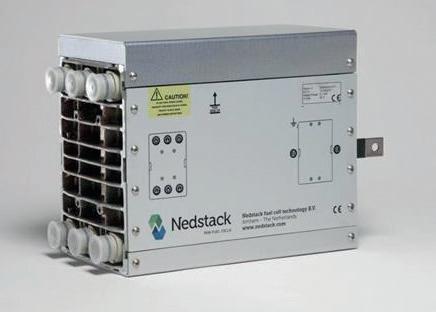
8 Research into pairing a sodium borohydride storage solution
with a PEM fuel cell was conducted under the the H2SHIPS project
previously covered Dutch research into several potential solutions under consideration.
The fuel cell work package includes research into new fuel cell systems with a greater power density, and a longer lifespan, as well as the use of residual heat and the scaling up of fuel cells.
The full list of work packages includes: data collection and system validation; system integration; modular testing; ship design; and safety.
“SH2IPDRIVE will ensure the Dutch maritime sector is in a prime position to respond to the expected market demand for hydrogen systems by providing the necessary innovation stimuli to the technology developers, suppliers, shipowners and shipbuilders and will strengthen the country’s competitive position as a leader in the field of maritime hydrogen applications.” Klaas Visser, Ship Design, Production & Operations - TU Delft.
Visser told The Motorship that the alternative hydrogen vectors merited further research, noting that sodium borohydride’s characteristics had implications for safety and fuel containment. Visser identified several key advantages associated with the hydrogen fuel technology, including a potential higher energy storage density (38.5 MJ/kg), that is similar to that of diesel fuel. While the material was flammable, it was slow-burning, by contrast with some other forms of hydrogen.
Visser noted that sodium borohydride also had a significantly higher volumetric density than compressed hydrogen. This meant that the space requirements for containment systems were lower, which was an advantage for PEM fuel cell applications. When based on a 250 kW PEM fuel cell, 5m3 of sodium borohydride would be sufficient to power the fuel cell for 70 hours of operation.

8 The consortium
includes Future Proof Shipping, which collaborated with Holland Shipyards on the retrofit of a 110m long inland container vessel for hydrogen-fuelled operation at the group’s yard in Hardinxveld earlier in 2020
SUCCESSFUL STRING TEST FOR PEMFC PROPULSION SYSTEM
Kongsberg successfully concluded a string test for a full-scale electric propulsion system based on 600kW of hydrogen-powered PEM fuel cells at a facility in Ågotnes outside Bergen on 1 December.
Kongsberg claims that the test was a world first for a full-scale, full-size, zero-emissions drivetrain powered by hydrogen-fuelled fuel cells designed for ships and ferries.
The full-scale HySeas III test at Kongsberg’s facility in Ågotnes, Norway on 1 December 2021 was attended by Minister of Trade and Industry Jan Christian Vestre, Egil Haugsdal, CEO of Kongsberg Maritime, and Geir Håøy, president of Kongsberg.
The test formed part of the EU funded HySeas project, which has been running since 2013 to prepare and demonstrate a scalable hydrogen system for ships and ferries. Kongsberg has been the technical lead of the project, which has also involved Caledonian Maritime Assets Limited (CMAL), McPhy Energy and Orkney Island Council, as well as Germany’s DLR Institute of Networked Energy Systems.
The installation of the Ballard HD-100 PEM fuel cells
The string test involves the assembly of key power-train components and testing them as a system, prior to the commencement of any ship building. The tests, which were devised and conducted by Kongsberg, are designed to evaluate and optimise system performance, response, control and safety. In this case, the testing mirrors the operational loads which would be experienced by a vessel on a route between Kirkwall and Shapinsay in Orkney.
The string test involved the fuel cell system, consisting of 6 x 100kW Ballard HD-100 fuel cells, two Multidrives, the vessel’s energy storage system and energy management systems, transformers and switchboards. Variable load banks were used to simulate azimuth and bow thrusters. The vessel’s hydrogen storage and piping system, cooling system and safety, alarm and detection systems were also included.
Kongsberg welcomed the string test, which will provide information about safe operation and the system’s power and fuel capacity requirements.
“With a verified and tested hydrogen-based propulsion system, we take the next step in zero-emission solutions at sea. This project is another example of our world-leading Norwegian maritime cluster succeeding when we face the most demanding technological challenges”, says Geir Håøy, president of Kongsberg.
The next step will be for land-based system to undergo a 4-month testing program for validation purposes with the aim of verifying the final design for an H2-powered RoPax ferry. The fuel cell-powered vessel will be designed by CMAL, which plans to complete the design in March 2022.
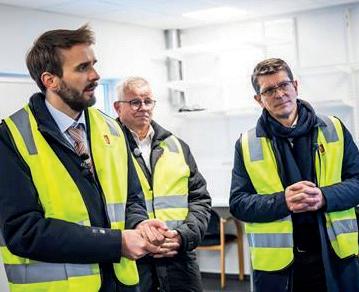
The test formed part of the EU funded HySeas project, to prepare and demonstrate a ‘‘ scalable hydrogen system for ships and ferries.
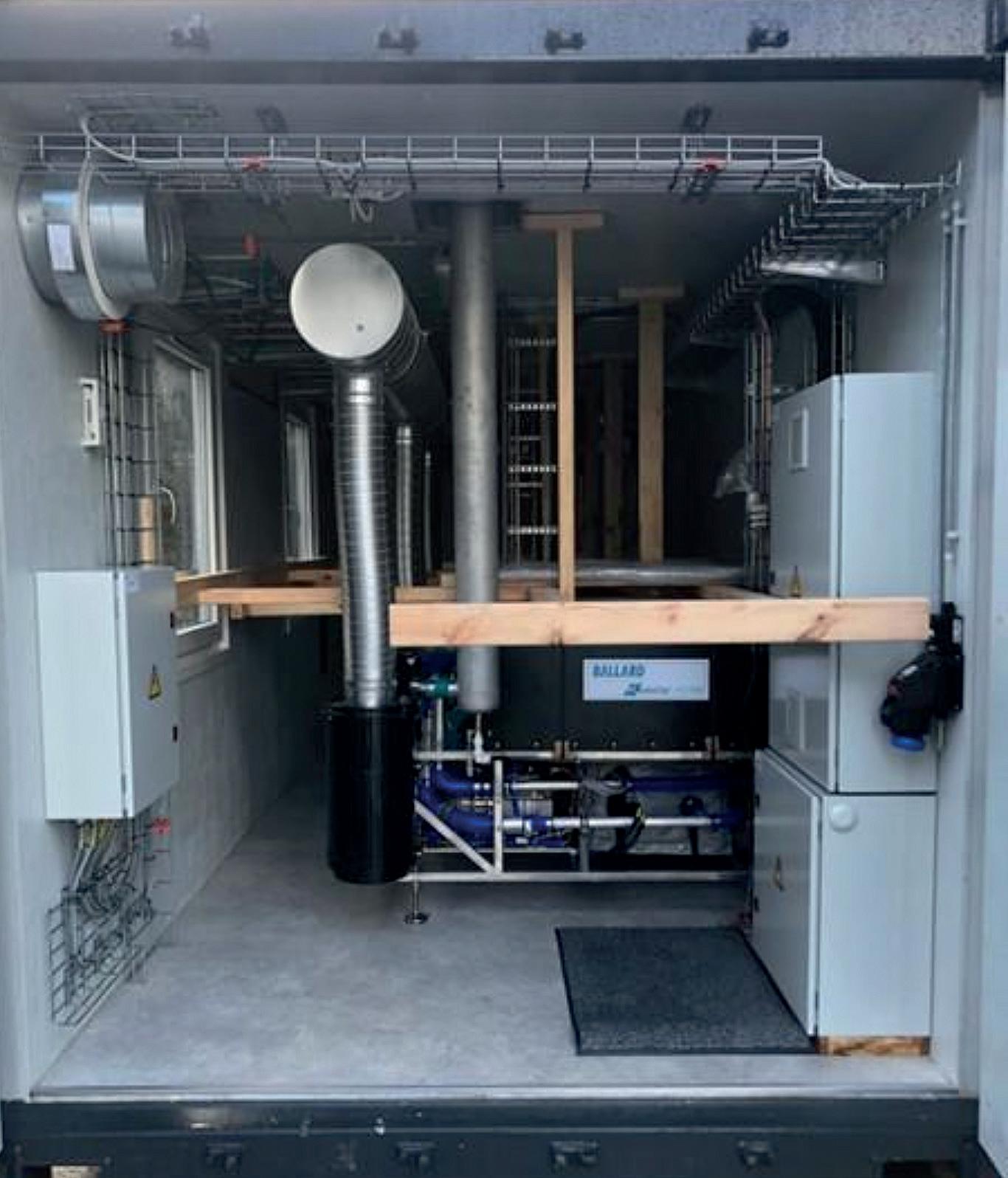
8 The installation of the Ballard HD-100 PEM fuel cells
8 The full-scale
HySeas III test at Kongsberg's facility in Ågotnes, Norway on 1 December 2021
Source: Kongsberg Maritime




